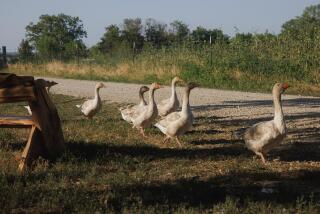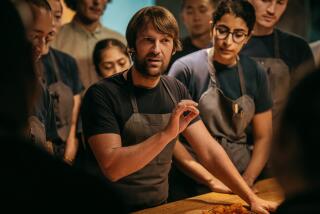Naked lunch
MICHAEL POLLAN has perfected a tone -- one of gleeful irony and barely suppressed outrage -- and a way of inserting himself into a narrative so that a subject comes alive through what heâs feeling and thinking. He is a master at drawing back to reveal the greater issues. At one point in his new book, âThe Omnivoreâs Dilemma,â he stands in the shed of a Virginia farm, knife in hand, trying to not make eye contact with the chicken he is about to kill: âIt seemed to me not too much to ask of a meat eater ... that at least once in his life he take some direct responsibility for the killing on which his meat-eating depends.â
Although Pollan has watched these chickens (âan eager, gossipy procession of Barred Rocks, Rhode Island Reds and New Hampshire Whitesâ) fan out across pastures as they feed, they are technically not organic. Thatâs because the farmer who raises them would rather buy feed corn from a local grower, who may have used a nonorganic herbicide, than buy âpure productâ transported from so far away that itâs âcoated in diesel fuel.â This is vintage Pollan; he closes in on a single chicken and broadens out to engage the larger argument. What does âorganicâ mean? How is the term abused and how did it become both a code word for purity and integrity and the rubric of a huge enterprise as beholden to fossil fuels and aggressive a marketer as the industrialized food chain it opposes?
A journalism professor at UC Berkeley, Pollan is a writer for whom structure is particularly important. Because he deals with nature and ideas, which donât have ready-made frames to drape a story on, he must come up with one. In his last book, âThe Botany of Desire: A Plantâs-Eye View of the World,â he did so brilliantly. Its thesis is that plants are smarter than we are and that by domesticating them weâve fallen in with their master plan to increase their habitat. His present book, about the American appetite, lacks the charm of that conceit but is more important. He asks us to consider our everyday decisions about eating: How do we make them, and what are the moral and ecological repercussions?
The book is divided into three sections, each on one of âthe three principal food chains that sustain us today: the industrial, the organic, and the hunter-gatherer.â Each culminates in a meal (two, in the organic section). First stop is the supermarket, the cornfieldâs point of sale. (Oh, would that he were talking about just-picked ears of corn, their silk still warm, kernels waiting for a knob of butter to make them perfect!) Everything we eat seems to come from the crop. âCorn is what feeds the steer that becomes the steak. Corn feeds the chicken and the pig, the turkey and the lamb, the catfish and the tilapia and, increasingly, even the salmon.... The eggs are made of corn. The milk and cheese and yogurt, which once came from dairy cows that grazed on grass, now typically come from Holsteins that spend their working lives tethered to machines, eating corn.â
The invention of synthetic nitrogen fertilizer by Fritz Haber (a German chemist who also invented Zyklon B) marks the moment when âthe basis of soil fertility shifted from a total reliance on the energy of the sun to a new reliance on fossil fuel.â The âflood tide of cheap cornâ this produced âmade it profitable to fatten cattle on feedlots instead of on grass.... Iowa livestock farmers couldnât compete with the factory-farmed animals their own cheap corn had helped spawn.â With that, Pollan is standing in a CAFO (confined animal feeding operation) on âthe high plains of western Kansas,â unsuccessfully looking for the cow he has bought and intends to follow until it comprises the patty of a McDonaldâs meal.
The second section centers on the aforementioned Virginia farm, owned by one Joel Salatin, an endearingly pugnacious man who classifies himself as âbeyond organic.â Their relationship gets off to a rocky start when Salatin refuses to FedEx a chicken and a steak to Pollan because the requisite dry ice, Styrofoam and jet fuel imperil environmental sustainability, which is much more important to him. When Pollan presses the âwhat is organic?â issue, Salatin obligingly explodes: âA ten-thousand-bird shed that stinks to high heaven or a new paddock of fresh green grass every day? Now which chicken shall we call âorganicâ? Iâm afraid youâll have to ask the government, because now they own the word.â
Pollan doesnât ask the government, but he does go to the quintessential purveyor of organic fare, Whole Foods Market. He coins the phrase âsupermarket pastoralâ for all that copy about âhumanely raisedâ and ârange fedâ and reveals most of it as an outright lie. A Whole Foods marketing consultant allows that such terms help convince shoppers that theyâre âengaging in authentic experiences.â The quaint little farms the chain wants you to think are its sources cannot fill the bill. âAs soon as your business involves stocking the frozen food case or produce section at a national chain,â Pollan writes, âwhether it be Wal-Mart or Whole Foods, the sheer quantities of organic produce you need makes it imperative to buy from farms operating on the same industrial scale you are.â Organic milk doesnât come from cows wandering the pasture but from massive feedlots where they eat organic corn but produce the same manure lakes as any other CAFO. As for organic chickens, they spend their short lives in a reeking shed with fans at each end, along with a bolt hole leading to a small grassy yard, in compliance with U.S. Department of Agriculture rules.
As I read, I felt myself troubled by a basic question. What did the title mean? It could be a term from behavioral science about the dangers faced by omnivores, such as rats and humans, that are tempted to eat something unsafe, or it could allude to plain old supermarket confusion about what to buy for dinner. Pollan doesnât make up his mind. Forewarned by this confusion, I was less surprised than I might have been to find the third section disappointing. Pollan sets off on a quest for the foraged meal. Among other things, he needs to get a gun license, learn to shoot, hunt for chanterelles and pan for salt in San Francisco Bay. No sooner has he hit the Berkeley Hills than he drops his entire tone and point of view. He meets an Italian who makes salami, and the book starts reading like bad Castaneda. Moreover, itâs hard to believe that a writer with Pollanâs gimlet eye can consider a meal that involves hunting in a private forest, crossing California in an SUV and the use of ATVs and GPS technology as living off the land. He seems to have been ambushed by his bookâs structure. After Iâve seen industrial agriculture destroyed and industrial organic eviscerated, I need to hear more than people in Berkeley carrying on about Italian cured meats. I want answers, bullet points, a program I can sign on to, at least a glimmer of hope that we can know where our food comes from and still enjoy it.
Fittingly, it is the land and gardening and what it means to Pollan that saves the book: âGrowing food has been my atavism of choice since I was ten years old, when I planted a âfarmâ in my parentâs suburban yard.... The mysteries of germination and flowering and fruiting engaged me from an early age, and the fact that by planting and working an ordinary patch of dirt you could in a few monthsâ time harvest things of taste and value was, for me, natureâs most enduring astonishment. It still is.â
Thatâs the man we see knife in hand and weak-kneed before an oblivious chicken at Salatinâs farm. Heâs followed the energy chain from sunlight to grass to chicken; after he inserts the knife heâll compost the entrails to start the whole cycle again. When Pollan writes that the resulting meal of chicken grilled over wood served with roast corn, a lemony rocket salad and a local Viognier has a âdeclarative quality,â where the foods taste âalmost flamboyantly themselves,â I found myself deeply moved that the earth can produce such bounty, that an author can put a single meal in its broadest context, and that, in the natural order of things, good food still has a place. *
More to Read
Sign up for our Book Club newsletter
Get the latest news, events and more from the Los Angeles Times Book Club, and help us get L.A. reading and talking.
You may occasionally receive promotional content from the Los Angeles Times.








